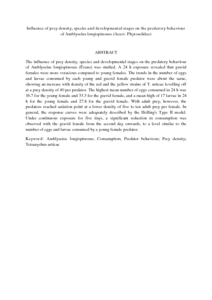Citation
Ibrahim, Yusof and Abdul Rahman, R. B.
(1997)
Influence of prey density, species and developmental stages on the predatory behaviour of Amblyseius longispinosus (Acari: Phytoseiidae).
Entomophaga, 42 (3).
pp. 319-327.
ISSN 0013-8959; ESSN: 1573-8248
Abstract
The influence of prey density, species and developmental stages on the predatory behaviour of Amblyseius longispinosus (Evans) was studied. A 24 h exposure revealed that gravid females were more voracious compared to young females. The trends in the number of eggs and larvae consumed by each young and gravid female predator were about the same, showing an increase with density of the red and the yellow strains of T. urticae levelling off at a prey density of 40 per predator. The highest mean number of eggs consumed in 24 h was 16.7 for the young female and 33.3 for the gravid female, and a mean high of 17 larvae in 24 h for the young female and 27.8 for the gravid female. With adult prey, however, the predators reached satiation point at a lower density of five to ten adult prey per female. In general, the response curves were adequately described by the Holling's Type II model. Under continuous exposure for five days, a significant reduction in consumption was observed with the gravid female from the second day onwards, to a level similar to the number of eggs and larvae consumed by a young female predator.
Download File
![[img]](http://psasir.upm.edu.my/51018/1.hassmallThumbnailVersion/Influence%20of%20prey%20density%2C%20species%20and%20developmental%20stages%20on%20the%20predatory%20behaviour%20of%20Amblyseius%20longispinosus%20%28Acari%20Phytoseiidae%29.pdf)  Preview |
|
PDF (Abstract)
Influence of prey density, species and developmental stages on the predatory behaviour of Amblyseius longispinosus (Acari Phytoseiidae).pdf
Download (5kB)
| Preview
|
|
Additional Metadata
Actions (login required)
 |
View Item |

